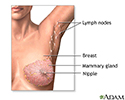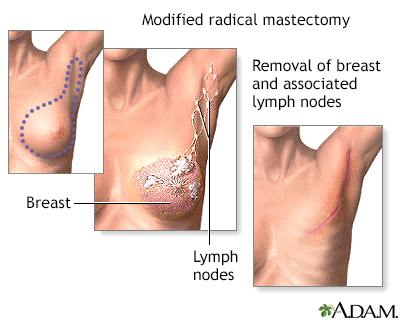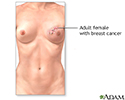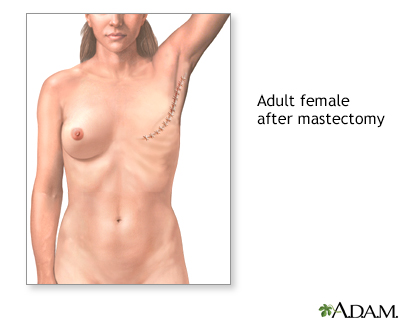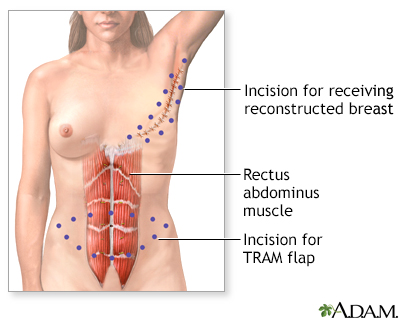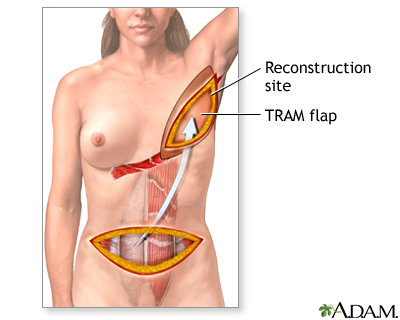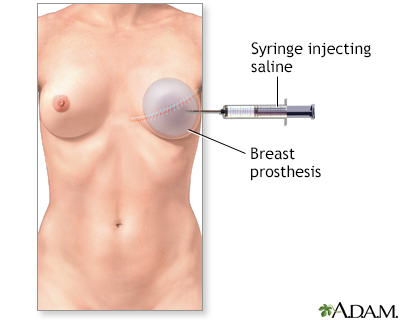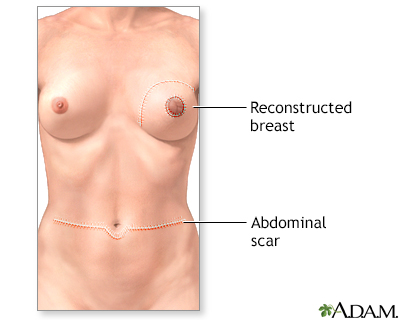Mastectomy
Breast removal surgery; Subcutaneous mastectomy; Nipple sparing mastectomy; Total mastectomy; Skin sparing mastectomy; Simple mastectomy; Modified radical mastectomy; Breast cancer - mastectomyA mastectomy is surgery to remove the breast tissue. Some of the skin and the nipple may also be removed. The surgery is most often done to treat breast cancer.
Breast cancer
Breast cancer is cancer that starts in the tissues of the breast. There are two main types of breast cancer:Ductal carcinoma starts in the tubes (du...

Description
Before surgery begins, you will be given general anesthesia. This means you will be asleep and pain-free during surgery.
General anesthesia
General anesthesia is treatment with certain medicines that puts you into a deep sleep so you do not feel pain during surgery. After you receive the...
Read Article Now Book Mark ArticleThere are different types of mastectomies. Which one your surgeon performs depends on the type of breast problem you have. Most of the time, mastectomy is done to treat breast cancer. However, it is sometimes done to prevent cancer (prophylactic mastectomy).
The surgeon will make a cut in your breast and perform one of these operations:
- Nipple-sparing mastectomy: The surgeon removes your entire breast, but leaves the nipple and areola (the colored circle around the nipple) in place. If you have cancer, the surgeon may do a biopsy of lymph nodes in the underarm area to see if the cancer has spread.
- Skin-sparing mastectomy: The surgeon removes your breast with the nipple and areola with minimal skin removal. If you have cancer, the surgeon may do a biopsy of lymph nodes in the underarm area to see if the cancer has spread.
- Total or simple mastectomy: The surgeon removes your entire breast along with the nipple and areola. If you have cancer, the surgeon may do a biopsy of lymph nodes in the underarm area to see if the cancer has spread.
Biopsy
A breast biopsy is the removal of breast tissue to examine it for signs of breast cancer or other disorders. There are several types of breast biopsi...
Read Article Now Book Mark Article - Modified radical mastectomy: The surgeon removes your entire breast with the nipple and areolar along with some of the lymph nodes underneath the arm.
- Radical mastectomy: The surgeon removes your entire breast with the nipple and areola along with the skin over your breast, all of the lymph nodes underneath the arm, and the skin is then closed with sutures (stitches).
One or two small plastic drains or tubes are very often left in your chest to remove extra fluid from where the breast tissue used to be.
A plastic surgeon may be able to begin reconstruction of your breast during the same operation. You may also choose to have breast reconstruction at a later time. If you have reconstruction, a skin- or nipple-sparing mastectomy may be an option.
Mastectomy will take about 2 to 3 hours.
Why the Procedure Is Performed
WOMEN DIAGNOSED WITH BREAST CANCER
The most common reason for a mastectomy is breast cancer.
If you are diagnosed with breast cancer, talk to your health care provider about your choices:
Talk to your health care provider about...
You may be having a mastectomy. This is surgery to remove your breast. Most often, a mastectomy is done to treat breast cancer. Sometimes, it is d...
Read Article Now Book Mark Article- Lumpectomy is when only the breast cancer and tissue around the cancer are removed. This is also called breast conservation therapy or partial mastectomy. Most of your breast will be left.
Lumpectomy
Breast lump removal is surgery to remove a lump that may be a breast cancer. Tissue around the lump is also removed. This surgery is called an exci...
 ImageRead Article Now Book Mark Article
ImageRead Article Now Book Mark Article - Mastectomy is when all breast tissue is removed.
You and your provider should consider:
- The size and location of your tumor
- Skin involvement of the tumor
- How many tumors there are in your breast
- How much of your breast is affected
- The size of your breast
- Your age
- Medical history that may exclude you from breast conservation (this may include prior breast radiation and certain medical conditions)
- Family history
- Your general health and whether you have reached menopause
You and the providers who are treating your breast cancer will decide together which option is right for you.
WOMEN AT HIGH RISK FOR BREAST CANCER
Women who have a very high risk of developing breast cancer may choose to have a preventive (or prophylactic) mastectomy to reduce the risk of breast cancer.
You may be more likely to get breast cancer if one or more close family relatives has had the disease, especially at an early age. Genetic tests (such as BRCA1 or BRCA2) may help show that you have a high risk. However, even with a normal genetic test, you may still be at high risk for breast cancer, depending on other factors. It may be useful to meet with a genetic counselor to assess your level of risk.
Prophylactic mastectomy should be done only after very careful thought and discussion with your doctor, a genetic counselor, your family, and loved ones.
Mastectomy greatly reduces the risk for breast cancer, but does not eliminate it.
You may decide to have a mastectomy based on your personal preference for a given condition. You and your provider will discuss the pros and cons of this decision.
Risks
Scabbing, blistering, wound opening, seroma, or skin loss along the edge of the surgical cut or within the skin flaps may occur.
Risks:
- Shoulder pain and stiffness. You may also feel pins and needles where your breast used to be and underneath the arm.
- Swelling of your arm (called lymphedema) on the same side as your breast that is removed. This swelling is not common, but it can be an ongoing problem.
Lymphedema
Lymphatic obstruction is a blockage of the lymph vessels that drain fluid from tissues throughout the body and allow immune cells to travel where the...
 ImageRead Article Now Book Mark Article
ImageRead Article Now Book Mark Article - Damage to nerves that go to the muscles of the arm, back, and chest wall.
- Loss of sensation of the skin of your chest wall.
Before the Procedure
You may have blood and imaging tests (such as CT scan, bone scan, PET scan) after your provider finds breast cancer. This is done to determine if the cancer has spread outside of the breast and lymph nodes under the arm. These tests are not needed if you have early stage breast cancer.
CT scan
A computed tomography (CT) scan is an imaging method that uses x-rays to create pictures of cross-sections of the body. Related tests include:Abdomin...

Bone scan
A bone scan is an imaging test used to diagnose bone diseases and find out how severe they are.

PET scan
A chest x-ray is an x-ray of the chest, lungs, heart, large arteries, ribs, and diaphragm.

Always tell your provider if:
- You could be pregnant
- You are taking any medicines or herbs or supplements you bought without a prescription
- You smoke
During the week before the surgery:
- Several days before your surgery, you may be asked to stop taking aspirin, ibuprofen (Advil, Motrin), naproxen (Aleve, Naprosyn), vitamin E, clopidogrel (Plavix), warfarin (Coumadin), and any other medicines that make it hard for your blood to clot.
- Ask which medicines you should still take on the day of the surgery.
On the day of the surgery:
- Follow instructions from your surgeon or nurse about eating or drinking before surgery.
- Take the medicines you have been told to take with a small sip of water.
You will be told when to arrive at the hospital. Be sure to arrive on time.
After the Procedure
Most women stay in the hospital for 24 to 48 hours after a mastectomy, though some women may be able to go home the day of surgery. Your length of stay will depend on the type of surgery you had. Many women go home with drainage tubes still in their chest after mastectomy. The drains will be removed later during an office visit. A nurse will teach you how to look after the drain, or you might be able to have a home care nurse help you.
After a mastectomy
You had a mastectomy. This is surgery that removes the entire breast. The surgery was done to treat or prevent breast cancer. Now that you're going...
Read Article Now Book Mark ArticleYou may have pain around the site of your cut after surgery. The pain is worst in the first few days after surgery and then goes away over a period of several weeks. You will receive pain medicines during your hospital stay. Talk with your surgeon about medicines to take for pain after surgery.
Fluid may collect in the area of your mastectomy after all the drains are removed. This is called a seroma. It most often goes away on its own, but it may need to be drained using a needle (aspiration).
Outlook (Prognosis)
Most women recover well after mastectomy.
In addition to surgery, you may need other treatments for breast cancer. If hormonal therapy or chemotherapy are indicated, you will meet with a medical oncologist. If radiation therapy is recommended, you will meet with a radiation oncologist.
Chemotherapy
The term chemotherapy is used to describe cancer-killing drugs. Chemotherapy may be used to:Cure the cancerShrink the cancerPrevent the cancer from ...

Radiation therapy
Radiation therapy uses high-powered radiation (such as x-rays or gamma rays), particles, or radioactive seeds to kill cancer cells.

References
Davidson NE. Breast cancer and benign breast disorders. In: Goldman L, Cooney KA, eds. Goldman-Cecil Medicine. 27th ed. Philadelphia, PA: Elsevier; 2024:chap 183.
Henry NL, Shah PD, Haider I, Freer PE, Jagsi R, Sabel MS. Cancer of the breast. In: Niederhuber JE, Armitage JO, Kastan MB, Doroshow JH, Tepper JE, eds. Abeloff's Clinical Oncology. 6th ed. Philadelphia, PA: Elsevier; 2020:chap 88.
Klimberg VS, Hunt KH. Diseases of the breast. In: Townsend CM Jr, Beauchamp RD, Evers BM, Mattox KL, eds. Sabiston Textbook of Surgery. 21st ed. Philadelphia, PA: Elsevier; 2022:chap 35.
Macmillan RD. Mastectomy. In: Dixon JM, Barber MD, eds. Breast Surgery: A Companion to Specialist Surgical Practice. 7th ed. Philadelphia, PA: Elsevier; 2024:112-121.
National Comprehensive Cancer Network website. NCCN clinical practice guidelines in oncology: breast cancer. Version 2.2024. www.nccn.org/professionals/physician_gls/pdf/breast.pdf. Updated March 11, 2024. Accessed March 26, 2024.
Breast cancer
Animation
The female breast is either of two mammary glands (organs of milk secretion) on the chest.
Female Breast
illustration
Mastectomy - series - Normal anatomy
Presentation
Breast reconstruction - series - Indication, part 1
Presentation
Review Date: 3/11/2023
Reviewed By: Debra G. Wechter, MD, FACS, General Surgery Practice Specializing in Breast Cancer, Virginia Mason Medical Center, Seattle, WA. Internal review and update on 02/04/2024 by David C. Dugdale, MD, Medical Director, Brenda Conaway, Editorial Director, and the A.D.A.M. Editorial team.



